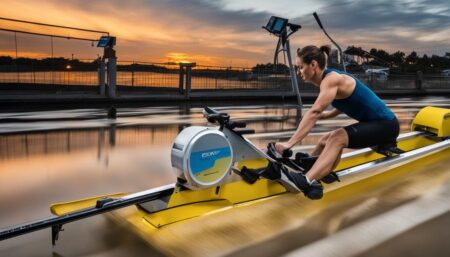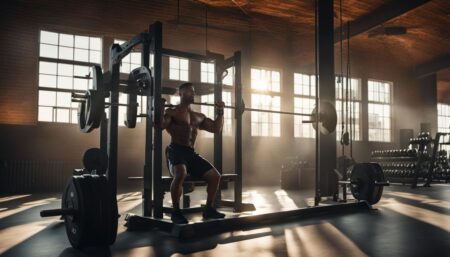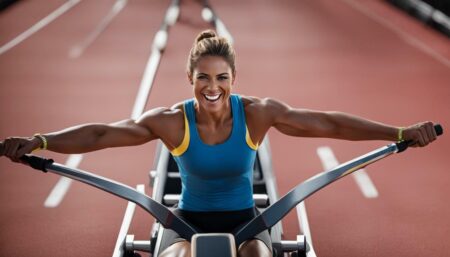Rowing machines can have some disadvantages that should be considered before incorporating them into your fitness routine. One of the main drawbacks is that proper form is crucial to prevent injury and get the full-body workout that a rowing machine is designed for. Poor form can lead to muscle fatigue and prevent the delivery of power in each stroke. Additionally, rowing can be repetitive and boring for some individuals, as it involves a consistent, repetitive motion. Noise levels can also be a concern, especially with traditional rowing machines that use fans or water tanks as resistance mechanisms. Finally, individuals with back injuries or chronic back problems may need to avoid rowing, as the motion can strain the lower back.
- Proper form is essential when using a rowing machine to avoid injury and maximize the effectiveness of the workout.
- Rowing can be repetitive and monotonous, which may impact motivation for some individuals.
- Noise levels can be a concern with certain types of rowing machines.
- Individuals with back injuries or chronic back problems should consider alternative exercises.
- Considering the drawbacks of rowing machines is important in determining if it’s the right workout option for you.
Importance of Proper Form on a Rowing Machine
One of the main drawbacks of using a rowing machine is that proper form is crucial for preventing injuries and achieving optimal results. When performing rowing exercises, it is essential to maintain a correct posture and technique to avoid strain on the muscles and joints. By using the proper form, you can engage the targeted muscle groups effectively and maximize the benefits of your workout.
Proper form on a rowing machine starts with maintaining a straight back and a neutral spine. This helps distribute the workload evenly throughout your body, preventing excessive stress on any particular area. It is also essential to engage your core muscles and avoid slumping or hunching forward, as this can lead to back strain and discomfort.
In addition to maintaining proper alignment, it is crucial to pay attention to your hand and arm positioning. Gripping the handle too tightly can cause unnecessary tension in the arms and shoulders. Instead, aim for a relaxed grip and focus on driving the movement from your legs and core, using your arms as a secondary force.
By practicing and maintaining the correct form on a rowing machine, you can minimize the risk of injury and optimize the effectiveness of your workout. Take the time to learn and understand the proper technique, and consult with a fitness professional if needed, to ensure you are getting the most out of your rowing machine workouts.
Muscle Fatigue and Power Delivery
When using a rowing machine with incorrect form, you may experience muscle fatigue and struggle to generate maximum power during your workout. Proper form is crucial when using a rowing machine to avoid injury and ensure an effective full-body workout. The rowing motion requires coordination between the legs, core, and upper body, and any deviation from the correct technique can hinder the delivery of power in each stroke.
To prevent muscle fatigue and optimize power delivery, it is important to maintain a strong and engaged core throughout the rowing motion. This helps to stabilize the body and transfer power efficiently from the legs to the upper body. It is also essential to drive with the legs and engage the back muscles, rather than relying solely on arm strength, to generate maximum power.
Proper technique involves a controlled and fluid motion, avoiding jerky movements or excessive leaning back at the end of the stroke. By focusing on maintaining a smooth and efficient rowing motion, you can minimize muscle fatigue and maximize the effectiveness of your workout. Remember to adjust the resistance level of the rowing machine to a setting appropriate for your fitness level and gradually increase intensity as your strength and endurance improve.
In summary, using a rowing machine with incorrect form can lead to muscle fatigue and hinder power delivery during your workout. To avoid these drawbacks, prioritize proper technique, engage core muscles, and focus on a smooth and controlled rowing motion. By doing so, you can maximize the benefits of using a rowing machine for a full-body workout.
Repetitive Nature of Rowing
One drawback of rowing machines is that the repetitive motion can become boring for some users, potentially leading to a lack of motivation. The consistent, repetitive nature of rowing can make the workout feel monotonous over time. This can be especially true for individuals who prefer variety in their exercise routines or who thrive on the excitement of different movements and activities.
However, it’s important to note that there are ways to overcome the repetitive nature of rowing machines. One option is to incorporate interval training into your rowing routine. By alternating between high-intensity bursts and recovery periods, you can add variety and intensity to your workout, keeping it engaging and stimulating.
Another way to combat boredom is to use rowing machine workouts as an opportunity for multitasking. For example, you can listen to music, audiobooks, or podcasts, or even watch TV shows or movies while rowing. By combining your workout with enjoyable activities, you can make the time fly and keep yourself entertained.
Here are some tips to make your rowing workouts more interesting:
- Try different rowing programs or challenges to vary your workout routine.
- Set goals and track your progress to stay motivated.
- Listen to your favorite music or podcasts while rowing.
- Join virtual rowing communities or classes to connect with others and stay motivated.
- Experiment with different resistance levels and rowing techniques to keep your muscles guessing.
By implementing these strategies and finding what works best for you, you can overcome the repetitive nature of rowing machines and continue to enjoy the benefits of this effective full-body workout.
| Pros | Cons |
|---|---|
| Full-body workout | Repetitive motion |
| Low impact on joints | Potential for boredom |
| Cardiovascular benefits | Requires proper form |
| Great for calorie-burning | Noisy (for certain types) |
Traditional rowing machines that utilize fans or water tanks for resistance can be quite noisy, which may be disruptive for some users. The repetitive swooshing sound of the fan or the splashing of water can be distracting, especially in quiet environments where concentration is key. If you live in an apartment building or have roommates, the noise generated by a rowing machine could also disturb others.
However, it’s worth noting that not all rowing machines produce the same level of noise. Many modern machines come equipped with magnetic or air resistance systems that operate silently, making them a great option for individuals who prefer a quieter workout environment. These machines offer the same benefits as traditional rowing machines but without the noise-related drawbacks.
For those who still prefer the experience of using a traditional rowing machine with a fan or water tank, there are ways to minimize the noise. Placing the machine on a rubber mat or carpet can help absorb some of the sound vibrations. Additionally, headphones or music can help mask the noise and provide a more enjoyable workout experience.

Noise levels can be a concern when using rowing machines, particularly those with fans or water tanks as resistance mechanisms. The repetitive swooshing sound or splashing of water can be disruptive and may not be suitable for those in quiet environments or shared living spaces. However, there are quieter alternatives available, such as rowing machines with magnetic or air resistance systems. Additionally, taking steps like using a rubber mat, playing music, or wearing headphones can help minimize the noise and create a more pleasant workout environment.
Considerations for Individuals with Back Injuries
Individuals with back injuries or chronic back problems should be cautious when using rowing machines, as the rowing motion can aggravate their condition. The repetitive nature of rowing and the strain on the lower back may cause discomfort or further injury. It is essential to consult with a healthcare professional before incorporating rowing into your exercise routine if you have a history of back issues.
Modifications may be necessary for those with back injuries to minimize the risk of exacerbating the condition. One option is to use a rowing machine with adjustable resistance settings, allowing for a gentler workout. Additionally, adjusting the footrest position and maintaining proper posture can help alleviate pressure on the lower back.
It is also worth considering alternative forms of cardiovascular exercise that are less demanding on the back. Low-impact exercises such as swimming, cycling, or using an elliptical machine can provide similar cardiovascular benefits without the strain on the back. These activities allow for a full-body workout while minimizing the impact on the spine.
Always listen to your body and pay close attention to any discomfort or pain during a rowing workout. If you experience worsening symptoms or increased pain, it is essential to stop the exercise and seek professional guidance. Remember, the goal is to prioritize your health and well-being while staying active and fit.
| Pros | Cons |
|---|---|
| Full-body workout | Potential for injury with poor form |
| Efficient calorie burning | Repetitive and monotonous |
| Low impact on joints | Noisy operation |
| Strengthens major muscle groups | Not suitable for individuals with back injuries |
Conclusion
While rowing machines offer numerous benefits, it is crucial to be aware of their limitations, especially for individuals with back injuries or chronic back problems. By taking precautions, modifying the workout as needed, and seeking professional guidance, it is possible to enjoy the benefits of rowing while minimizing the risk of further injury. It is always best to prioritize your safety and consult with a healthcare professional before starting or modifying any exercise routine.
Conclusion
While rowing machines offer many benefits, it’s essential to be aware of the potential drawbacks they have in order to make an informed decision about incorporating them into your fitness routine.
One of the main disadvantages of rowing machines is the importance of proper form. To prevent injury and receive the full-body workout that a rowing machine is designed for, maintaining proper form is crucial. Poor form can lead to muscle fatigue and hinder power delivery in each stroke.
Additionally, rowing can be repetitive and monotonous for some individuals. The consistent, repetitive rowing motion may not be enjoyable and can impact motivation to continue using the machine.
Noise levels can also concern rowing machines, especially traditional ones that use fans or water tanks as resistance mechanisms. The noise produced during a workout can be distracting or disruptive, especially in home environments.
Lastly, individuals with back injuries or chronic back problems should consider the potential strain rowing can have on the lower back. The rowing motion can exacerbate existing back issues and may not be suitable for those with these conditions.
By understanding these potential drawbacks, you can decide whether a rowing machine is the right workout option for you. While they offer a full-body workout and numerous benefits, it’s important to consider the limitations and address any specific concerns you may have before incorporating them into your fitness routine.
FAQ
What are the disadvantages of a rowing machine?
Rowing machines have several drawbacks, including the importance of maintaining proper form, the potential for muscle fatigue and power delivery issues, the repetitive nature of the workout, the noise levels, and the considerations for individuals with back injuries.
What is the importance of proper form on a rowing machine?
Proper form is crucial to prevent injury and maximize the effectiveness of your workout on a rowing machine. Poor form can lead to muscle fatigue and prevent power delivery in each stroke.
How can poor form on a rowing machine lead to muscle fatigue and hinder power delivery?
When using a rowing machine with poor form, your muscles may fatigue quickly and be unable to deliver the necessary power in each stroke. This can prevent you from achieving the full-body workout that a rowing machine is designed for.
What are the drawbacks of the repetitive nature of rowing?
Rowing involves a consistent, repetitive motion that can become monotonous for some individuals. This repetitiveness may lead to boredom and a lack of motivation to continue using the rowing machine as a workout option.
Why can rowing machines be noisy?
Specific rowing machines, particularly those with fans or water tanks as resistance mechanisms, can produce noise during operation. This noise level may be a consideration for individuals who prefer a quieter workout environment.
How does rowing impact individuals with back injuries?
Rowing may not be suitable for individuals with back injuries or chronic back problems because the motion of rowing can strain the lower back. It’s important to consider this potential strain before incorporating rowing into your workout routine.
What are the overall disadvantages of rowing machines?
Rowing machines have certain limitations and issues, including the importance of proper form, the potential for muscle fatigue and power delivery issues, the repetitive nature of the workout, the noise levels, and the considerations for individuals with back injuries. It’s important to consider these factors before deciding if rowing is the right workout option for you.






